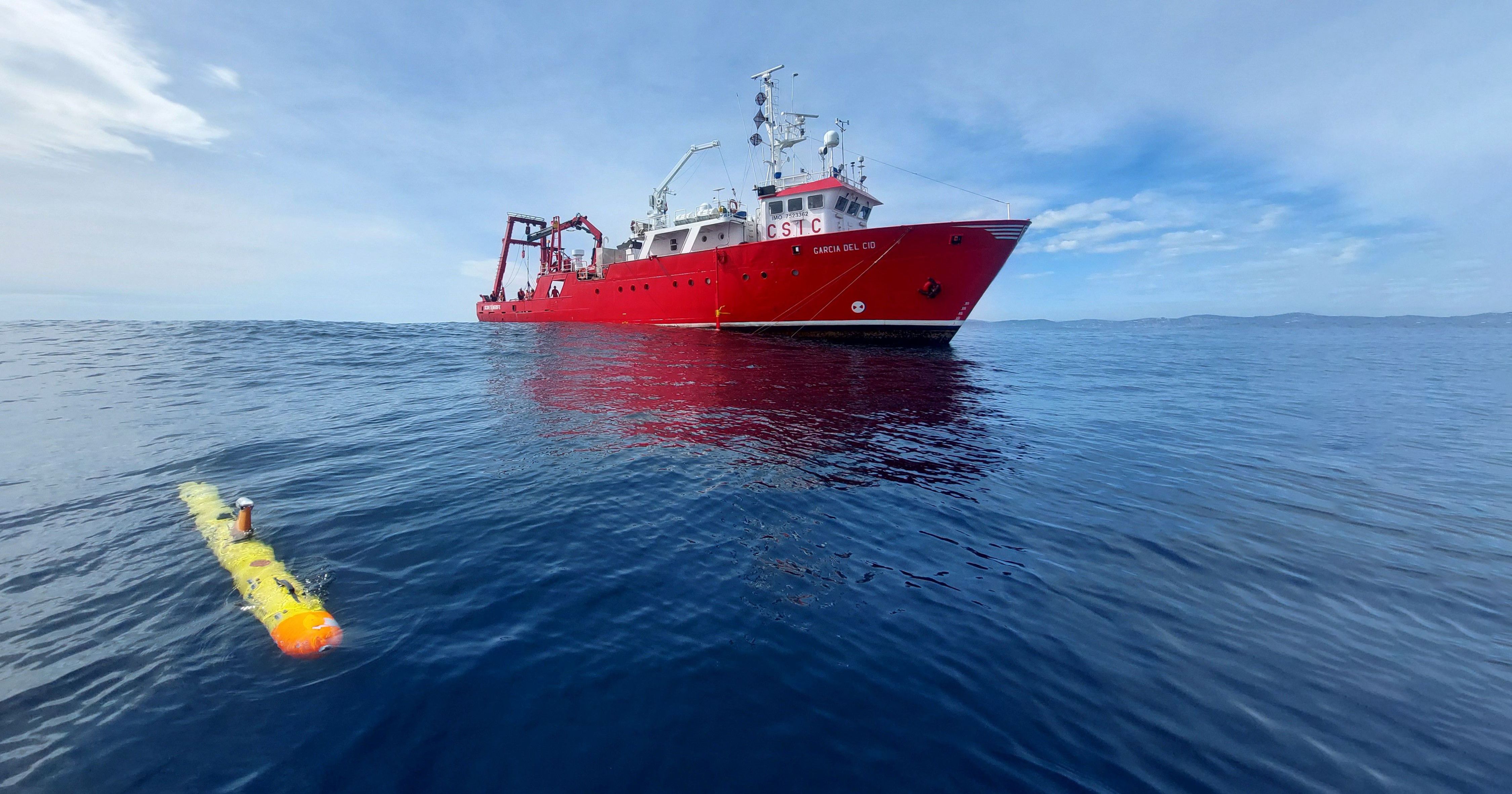30 / 03 / 2023

The autonomous underwater robot AUV Barabas and the research vessel García del Cid © VLIZ | Wieter Boone
Underwater robots have been on the rise in scientific research for some time. Their deployment is leading to new insights in marine research as they allow researchers to make observations with a higher resolution and on a larger scale in time and space. Such is the case in the Golfe du Lion, in the northwestern Mediterranean near Catalonia, Spain.
Below the surface of the Golfe du Lion, large submarine canyons – such as Blanes, Palamós and Cap de Creus – cut through the continental margin. These submarine canyons are under strong influence of dense water coming from the continental shelf. Dense water is created when cold and dry winds blow over the continental shelf in winter. The wind both cools the surface water and increases evaporation, which increases the density of the water. As soon as this surface water becomes denser than the underlying water, it sinks and flows over the edge of the continental shelf, through the submarine canyons, to the seabed. This process of stepwise sinking of dens water takes place for a short period every year and supplies the deep sea with fresh oxygen, chlorophyll, and nutrients. The seabed and bottom-dwelling communities benefit from it. Submarine canyons therefore have a high biological diversity. They host important communities of cold-water corals, which serve as nurseries for many commercial species of fish and crustaceans. However, trawling in the area is pernicious for this fragile marine ecosystem and other bottom-dwelling organisms also suffer from it.
Besides nutrients, the dense water can also transport coarse sediments within the canyons. In this context, within the project ABRIC, the Spanish Institut de Ciències del Mar (CSM-CSIC) is investigating the indirect effects of trawling on ecosystems in the canyons. For example, they are investigating the extent to which bottom trawling increases the concentration of sediment in the water and whether the sedimentation rate increases.
Before the researchers can evaluate the seabed changes caused by trawls, high-resolution mapping of the seabed is needed. To this end, the scientists partnered with the VLIZ Marine Robotics Centre in March 2023. From the Spanish research vessel García del Cid, the autonomous underwater robot AUV Barabas dived to a section of the Blanes canyon touched by trawls. As a result, the scientists obtained visual evidence of seabed alteration. The results will serve to support corrective measures and mitigation actions aimed at the fishing industry. For example, less disruptive trawling gear can reduce sediment resuspension and erosion and encourage the transition towards a more sustainable fishery.
In the same area, the University of Barcelona, within the FARDWO project, is studying the effects of dens water in the submarine canyon of Cap de Creus. Scientists are investigating the physical processes involved in dense shelf water cascading, but are also looking at how dens water can change the morphology of the seabed in the short and longer term. Over the past month, the AUV Barabas and the Ocean Glider Yoko have been collecting high-resolution data from the seafloor of the canyon and the overlying water column, respectively. These data should show the origins, variability, trends, impacts and far-reaching consequences of the formation of dens water overflows and how this process is changing due to climate change.
AUV Barabas
AUV Barabas is a torpedo shaped diving robot. The AUV has a depth rating of 1000 m and a survey speed of 3.3 knots. By bringing the sonar sensors to 10 m above the seafloor, she can map the seafloor in unprecedented detail. During the cruise onboard R/V García del Cid in March 2023 the AUV sailed 190 km of survey lines and was more than 36 hours on mission during the 12 executed dives. The VLIZ Marine Robotics Centre pilots Fred Fourie, Kobus Langedock and Wieter Boone led the dives.
Ocean Glider Yoko
Ocean Glider Yoko is a diving robot remotely controlled from Ostend by the VLIZ Marine Robotics Centre pilots Roeland Develter, Fred Fourie, Geoffrey Johnen and Chris Peck. The ocean glider dives and rises in a sawtooth pattern through the water (up to 1000 m deep) to measure the properties of the water column in high detail (currents, temperature, oxygen content, fluorescence and salinity). Yoko sailed on a transect of 26 km along the outer continental shelf and has travelled 535 km in 22.8 days. The purpose of this is to get a thorough description and quantification of the dense cold water that propagates towards the deep sea in the study area.